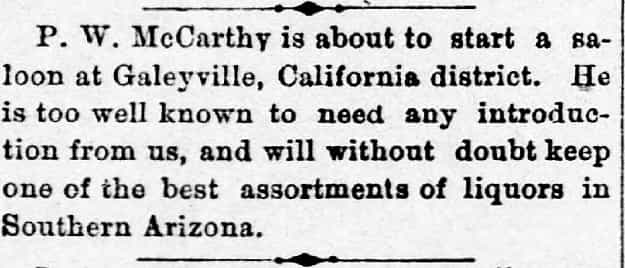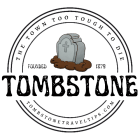Galeyville, Arizona was well-known to those who lived in Tombstone Arizona in the 1880’s. Tombstone was the county seat for Cochise County for awhile back then. The law and courts in town oversaw that area. Take a look at its story, so often mentioned when viewing the history of Tombstone. You’ll find some interesting people who frequented that town in the Old West.

A Ghost Town Now?
Miners regularly looked to the latest best opportunity. Some saw their options there in Galeyville Arizona, a town officially established at the end of 1880.3 Cowboys also frequented the town, as they roamed throughout Southeast Arizona. Curly Bill Brocius was associated with this community – but not for mining! We’ll discover one of his escapades there, getting to know a bit more about his true personality.
Named for John H. Galey
John H. Galey was from Titusville, Pennsylvania.1 He was president of the Texas Consolidated Mining & Smelting Co.3 Silver and lead were the ores gotten from their claims, that was their specialty.
In mid December of 1880 about 200 people were living in Galeyville Arizona. Some were there to mine, but others were about to open businesses.6 Aiming to supply the needs of the local miners. Mrs. Dickinson built a hotel which was nearly ready by the end of that year. Houses were being built. More people were coming in each day.
Galeyville Arizona – A Miner’s Town!
By the end of January 1880 a Phoenix newspaper had taken note of this booming new town. They gave an assessment:
- A telegraph line was in the planning stages and would soon be built. Brought in by S.M. Wessels (one of Texas Consolidated’s management team).
- A stage line for transportation was needed. So Wells Fargo was soon to open an office in town.
- But of course for relaxation after a hard day’s work – the paper noted there were already plenty of Galeyville saloons – an Arizona necessity!
- They also observed there wasn’t a church or school to be found!

Going Strong Through May 1881
Glowing reports of the mining status reached Arizona newspapers in the first part of 1881. Galeyville Arizona was booming! The Post Office was official on January 6, 1881.3
A writer to the Arizona Weekly Citizen reported that two other Mining Companies came to town. Between the three mining enterprises, plus individual claims, he estimated at least 800 claims were being worked.


Comparison to Tombstone
The local paper, the Galeyville Bulletin, promoted their town’s mining operations. They said it would be better than what could be developed in the Tombstone area because of their location. They were on the Eastern foothills of the Chiricahua Mountains. They had ready access to running streams and lots of timber. Ideal resources for the needs of mining companies.7
In early April 1881, their editor equated $40 of Galeyville ore to be worth $60 of ore coming out of Tombstone mines. That because of the superior ease of working and production of the local ores. Because of the ease of these circumstances.7
But was that quite accurate – or an overstated optimism? Well, soon trouble was to begin for Galeyville Arizona. The first hint was when the local newspaper itself stopped publishing! This fact was even noticed all the way in Yuma AZ, along the California border:

Cowboys, Including Curly Bill Brocius,
Around Town
Complaints began, in particular around September 1881, about the actions of the “Cochise County Cowboys” in the vicinity of Galeyville. Acting Arizona Territorial Governor Gosper even wrote to the Secretary of State concerning the situation in Southeast Arizona. He complained “at Galeyville, San Simon and other points… the cowboy element at times fully predominates, and the officers of the law are… unable to control this class of outlaws…”
The Arizona Star of Sept. 10, 1881 told of a Galeyville poker game robbery. It was led by David Estes, “one of two men who robbed a game of about four hundred dollars…” The other man mentioned is known to have been Johnny Ringo.
When they were brought to trial in Tombstone, none of the witnesses would appear and testify! Therefore, the pair couldn’t be convicted.
An incident involving Curly Bill Brocius during the first half of 1881 almost cost him his life! He was with another cowboy, James Wallace. They were drinking in Galeyville saloons. In one saloon in particular, they got into an argument. As it got heated their friends separated the two of them. They left, apparently intending to go into different bars in town.1
About the same time, they both exited through the swinging doors, nearly opposite each other – going out onto the dusty main street. James got his horse as if to leave town. But while doing that, he also got his Colt 45, turned and shot at Curly Bill, the bullet going into his neck and out his cheek!1,4

Amazingly it missed all vital areas in that small space, but fractured his jawbone. At first it was reported as a mortal wound.2 A local man took charge, backing up the situation with his Sharp’s Rifle. He made sure the cowboys who took sides in the issue didn’t cause any more problems. Wallace was arrested by Sheriff Billy Breckenridge.5 No charges after his hearing.2
Attacks + Bad Management
In September 1881, the people of Galeyville Arizona had asked the military for arms for protection. The arrangement was for the military Command to sell them surplus.8 They decided they had an excess 20 rifles with 1000 cartridges.9
The town and military felt an imminent threat of attack from native peoples, whose traditional lands they were actually now occupying in South Eastern Arizona. Many Galeyville locals just left town. Galeyville Arizona was right within the area that had been historical Chiricahua Apache lands.


Surprisingly, after the Epitaph’s report on March 6, 1882 Tucson’s Daily Star begins printing a Notice for three months. It read that creditors of John Galey from Texas Consolidated should present to his office in Galeyville any financial claims owed them. They would be compared with his books and the “correct amount of his indebtedness be ascertained.”
In late April of 1882 there’s word that a band of “hostiles” were moving toward Southeast Arizona. Some say they’d attacked at Galeyville. Even that the town had been “wiped out.” A May 1st report in the Tombstone Epitaph cleared up that rumor as false. But a local individual did report that mining was suspended. A battle with Apaches occurred in the area, but it really only affected the town psychologically. Naturally the people were fearful.4
In September 1882’s Tombstone Epitaph, promotions began advertising “Mines, Machinery & Other Property” from Texas Consolidated for sale.
Galeyville Arizona – the Ghost Town
By June 10, 1882 the Galeyville Arizona Post Office closed. Local mail was sent to Wilcox. Quite a distance to have to go to get your mail, especially in those days. On July 2, 1882 Tucson’s Weekly Citizen hinted at the financial condition of mining in town: “The failure made by the company had the effect of deadening the camp…”
Some internet search resources say the mines gave out, but most believe it was bad business decisions by Galey. The way he was running Texas Consolidated. Most of the miners moved on. That was understandable: they weren’t getting paid!! So, businesses in town closed, as a result.
Some internet search sources say that Galeyville only lasted as a town during 1881 and 1882: only two years. That it became a ghost town after that. But is that the case?
On July 15, 1882 the Tombstone Epitaph reported Census results for Cochise County. They criticized its accuracy, saying it under reported the population by 33%! It complained that “Galeyville is not mentioned in the table, but… that place is included in Morse’s Mill and vicinity.” The count there reported 94, vs. Tombstone at 5,300! What’s strange is Morse’s Mill is even more obscure than Galeyville – just a sawmill area built by Morse & Co. near Camp Bowie.
But Galeyville Arizona continued on. In December 1883 a few incidents happened when the law interviewed citizens living in Galeyville. It seemed outlaws still were drawn to the town.10 Individual small mining operations were there at least as late as 1902. E.J. Hands lived in Galeyville, and sold his mine there to P.H. Clark.11
On May 4, 1886 the Tombstone Epitaph was happy to report a Wild West Show was in town that evening at City Hall (of all places!). The heading called it the “Greatest Show on Earth” with “Unprecedented Attractions.” After appearing in Tombstone, they headed to other local towns, among which was Galeyville. Why go there, if there was no audience to behold their performance?
From July 1886 until at least 1896, the Cochise County Board of Supervisors regularly assigned Galeyville Precinct numbers, plus Inspector and Judge posts for elections. At times, though, nobody in Galeyville even voted.12
But in the November 6, 1894 election The Cochise County Board of Supervisors officially reported the votes from Galeyville. For Congress: 6-Democrat, 3-Republican, 1-People’s Party. For Councilman-at-Large: 7-Dem, 2-Rep, 1-People’s. Councilman: 8-Dem, 2-Rep. Sheriff: 6-Dem, 4-Rep ( The Republican candidate was Tombstone photographer C.S. Fly – he won with a total of 730 votes over 425 for his opponent Scott White.)13
Not much is known regarding what happened to John Galey when he left town, essentially broke. But rumor was he recovered and made a fortune in Texas oil! The mine’s smelter was sent to Benson Arizona. Many structures were taken down and carted off to Paradise, Arizona, a little south. The materials used for buildings there. Only a few buildings, some foundations and a slag dump were left in Galeyville by early 1911. Now it’s hard to detect any town was there at all.5 A few people do still live in the area, though.
Thus today Galeyville Arizona is fundamentally a Ghost Town!
References
1 Trimble, M. (2017, July 7). The outlaw king of Galeyville. True West. Retrieved from truewestmagazine.com/outlaw-king-galeyville/
2 Record Union (1881, May 21) Cowboys making things lively – One of them brought to grief by a comrade – Legal execution. P. 8 Sacramento, California.
3 Granger, B.H. (1983) Arizona’s names: X marks the place. Treasure Chest Publications. Tucson, Arizona.
4 Bailey, L.R. (1996) A tenderfoot in Tombstone: The private journal of George Whitwell Parsons: The turbulent years, 1880-82. Westernlore Press. Tucson Arizona.
5 Breackenridge, W.M. (1928) Helldorado. Copyright renewed 1956 Adam, F.E. Intro, Notes, Index Copyright 1982 R.R. Donnelly & Sons, Lakeside Press. Bison Book Edtion 1992, University of Nebraska Press.
6 Arizona Daily Star (1880, Dec. 5). California district. Sunday morning edition. P. 3 Tucson Arizona.
7 Arizona Sentinel (1881, April 9). Galeyville district. Arizona Mining News. P. 3. Yuma, Arizona.
8 Arizona Weekly Citizen (1881, Sept. 18). Movement of troops. Special to the Citizen, Willcox, September 11. Coast News. Tucson, Arizona.
9 Weekly Arizona Miner (1881, Sept. 23). Arms for distribution. Local Intelligence. P. 3. Prescott, Arizona.
10 Tucson Citizen (1883, Dec. 15). Pacific coast. San Simone Station, A.T. Dec. 12. Telegraph. P. 2. Tucson Arizona.
11 Arizona Republican (1902, March 14). Hand Bro’s mines in Cochise County sold to P.H. Clark. Deal for Lead Property. Friday Morning. P. 5 Arizona Publishing Co., Phoenix.
12 Tombstone Epitaph (1894, Nov. 11). From Friday’s daily. P. 3 Published every Sunday, S.C. Bagg, Editor and Proprietor. Tombstone, Arizona.
13 Tombstone Epitaph (1894, Nov. 25). Official report: Of the Board of Supervisors of Cochise County. P. 3. Published every Sunday, S.C. Bagg, Editor and Proprietor. Tombstone, Arizona.

Pingback: The Best Ghost Towns in Today's South-Western State!
We live nearby in Paradise. Galeyville is situated on posted private property and is not accessible to the public….